Berg J.M., Tymoczko J.L., Stryer L. Biochemistry
Подождите немного. Документ загружается.

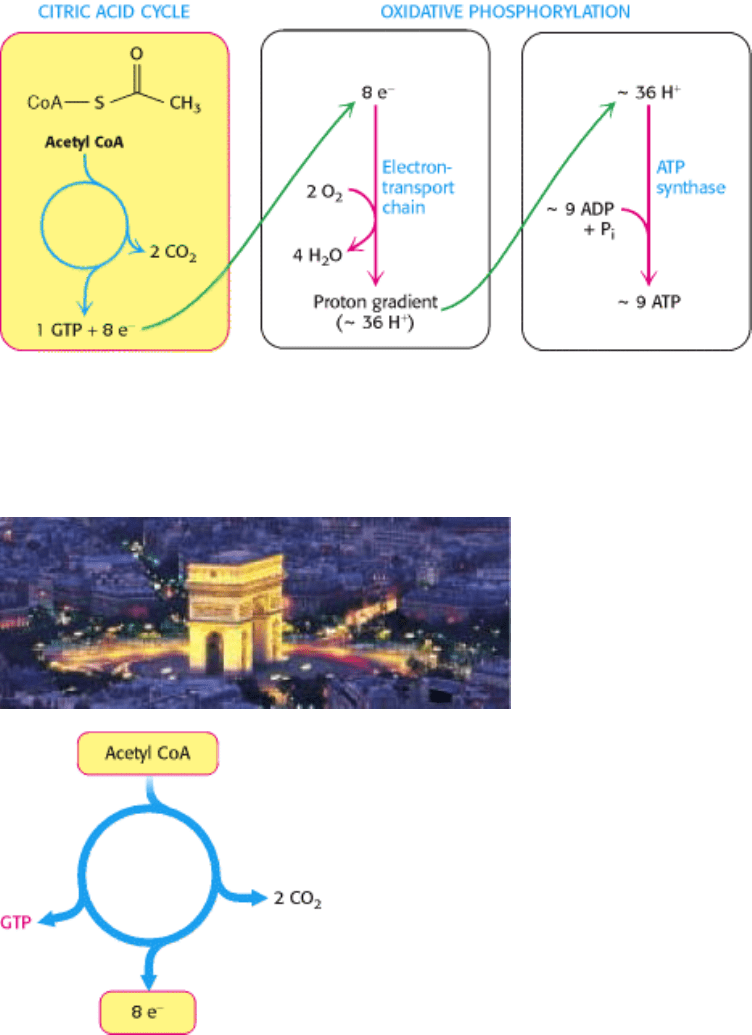
II. Transducing and Storing Energy 17. The Citric Acid Cycle
Figure 17.3. Cellular Respiration. The citric acid cycle constitutes the first stage in cellular respiration, the removal of
high-energy electrons from carbon fuels (left). These electrons reduce O
2
to generate a proton gradient (middle), which
is used to synthesize ATP (right). The reduction of O
2
and the synthesis of ATP constitute oxidative phosphorylation.
II. Transducing and Storing Energy 17. The Citric Acid Cycle
Roundabouts, or traffic circles, function as hubs to facilitate traffic flow. The citric acid cycle is the biochemical hub
of the cell, oxidizing carbon fuels, usually in the form of acetyl CoA, as well as serving as a source of precursors for
biosynthesis. [(Above) Chris Warren/International Stock.]
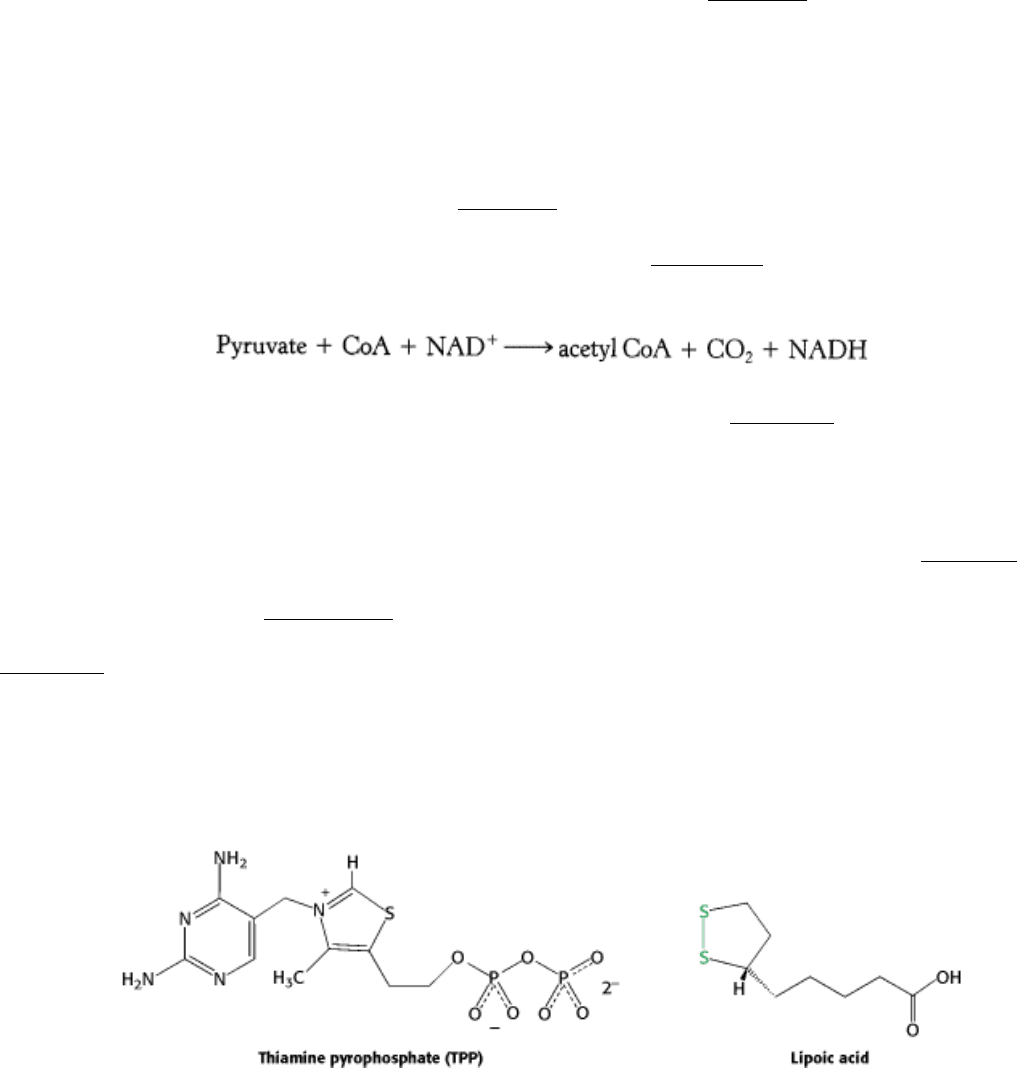
II. Transducing and Storing Energy 17. The Citric Acid Cycle
17.1. The Citric Acid Cycle Oxidizes Two-Carbon Units
Acetyl CoA is the fuel for the citric acid cycle. This important molecule is formed from the breakdown of glycogen (the
storage form of glucose), fats, and many amino acids. Indeed, as we will see in Chapter 22, fats contain strings of
reduced two-carbon units that are first oxidized to acetyl CoA and then completely oxidized to CO
2
by the citric acid
cycle.
17.1.1. The Formation of Acetyl Coenzyme A from Pyruvate
The formation of acetyl CoA from carbohydrates is less direct than from fat. Recall that carbohydrates, most notably
glucose, are processed by glycolysis into pyruvate (Chapter 16). Under anaerobic conditions, the pyruvate is converted
into lactic acid or ethanol, depending on the organism. Under aerobic conditions, the pyruvate is transported into
mitochondria in exchange for OH
-
by the pyruvate carrier, an antiporter (Section 13.4). In the mitochondrial matrix,
pyruvate is oxidatively decarboxylated by the pyruvate dehydrogenase complex to form acetyl CoA.
This irreversible reaction is the link between glycolysis and the citric acid cycle. (Figure 17.4) Note that, in the
preparation of the glucose derivative pyruvate for the citric acid cycle, an oxidative decarboxylation takes place and high-
transfer-potential electrons in the form of NADH are captured. Thus, the pyruvate dehydrogenase reaction has many of
the key features of the reactions of the citric acid cycle itself.
The pyruvate dehydrogenase complex is a large, highly integrated complex of three kinds of enzymes (Table 17.1).
Pyruvate dehydrogenase is a member of a family of homologous complexes that includes the citric acid cycle enzyme α-
ketoglutarate dehydrogenase (Section 17.1.6), a branched-chain α-ketoacid dehydrogenase, and acetoin dehydrogenase,
found in certain prokaryotes. These complexes are giant, with molecular masses ranging from 4 to 10 million daltons
(Figure 17.5). As we will see, their elaborate structures allow groups to travel from one active site to another, connected
by tethers to the core of the structure. The mechanism of the pyruvate dehydrogenase reaction is wonderfully complex,
more so than is suggested by its relatively simple stoichiometry. The reaction requires the participation of the three
enzymes of the pyruvate dehydrogenase complex, each composed of several polypeptide chains, and five coenzymes:
thiamine pyrophosphate (TPP), lipoic acid, and FAD serve as catalytic cofactors, and CoA and NAD
+
are stoichiometric
cofactors.
At least two additional enzymes regulate the activity of the complex.
The conversion of pyruvate into acetyl CoA consists of three steps: decarboxylation, oxidation, and transfer of the
resultant acetyl group to CoA.

These steps must be coupled to preserve the free energy derived from the decarboxylation step to drive the formation of
NADH and acetyl CoA. First, pyruvate combines with TPP and is then decarboxylated (Figure 17.6). This reaction is
catalyzed by the pyruvate dehydrogenase component (E
1
) of the multienzyme complex. A key feature of TPP, the
prosthetic group of the pyruvate dehydrogenase component, is that the carbon atom between the nitrogen and sulfur
atoms in the thiazole ring is much more acidic than most =CH- groups, with a pK
a
value near 10. This center ionizes to
form a carbanion, which readily adds to the carbonyl group of pyruvate.
This addition is followed by the decarboxylation of pyruvate. The positively charged ring of TPP acts as an electron sink
that stabilizes the negative charge that is transferred to the ring as part of the decarboxylation. Protonation yields
hydroxyethyl-TPP.
Second, the hydroxyethyl group attached to TPP is oxidized to form an acetyl group and concomitantly transferred to
lipoamide, a derivative of lipoic acid that is linked to the side chain of a lysine residue by an amide linkage.
The oxidant in this reaction is the disulfide group of lipoamide, which is reduced to its disulfhydryl form. This reaction,
also catalyzed by the pyruvate dehydrogenase component E
1
, yields acetyllipoamide.
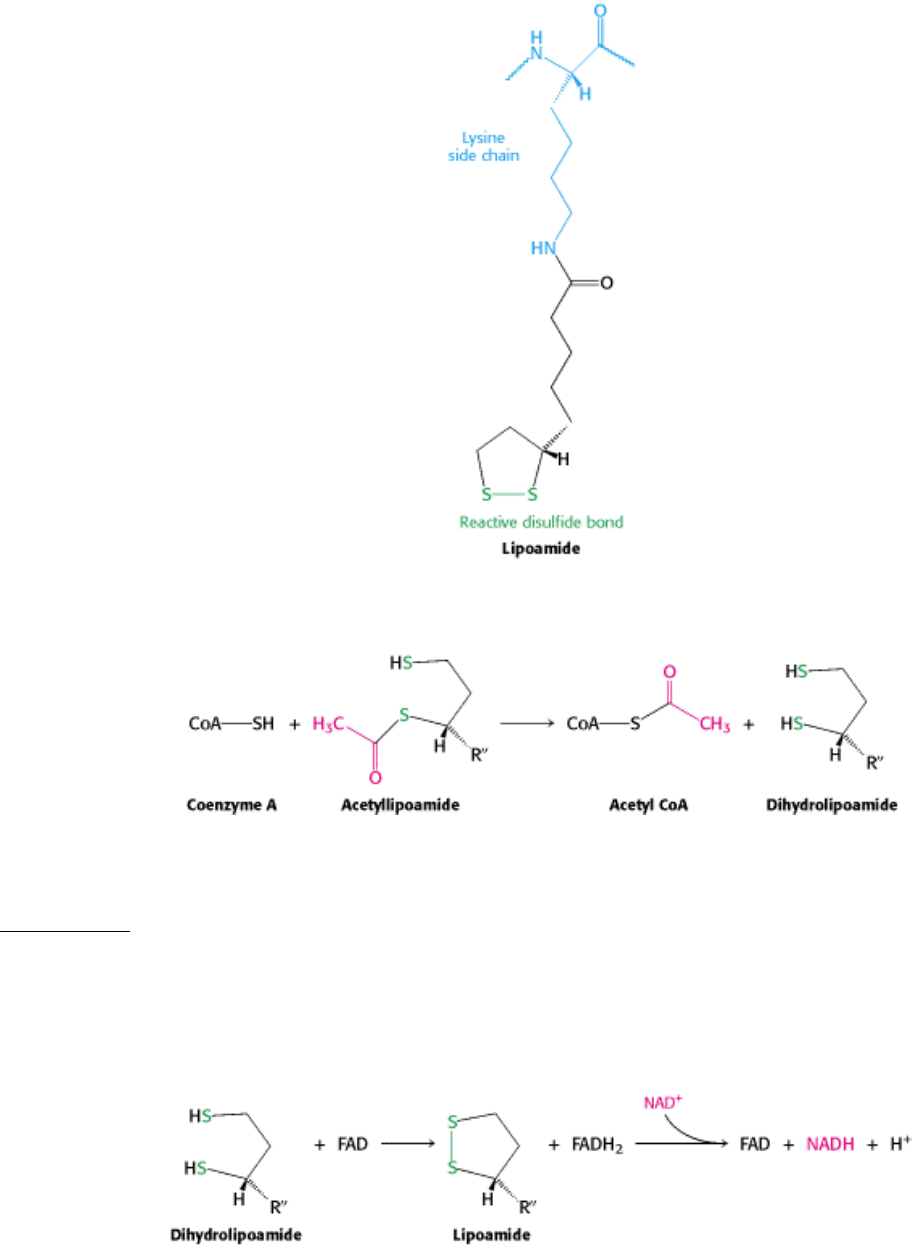
Third, the acetyl group is transferred from acetyllipoamide to CoA to form acetyl CoA.
Dihydrolipoyl transacetylase (E
2
) catalyzes this reaction. The energy-rich thioester bond is preserved as the acetyl group
is transferred to CoA. Recall that CoA serves as a carrier of many activated acyl groups, of which acetyl is the simplest
(Section 14.3.1). Acetyl CoA, the fuel for the citric acid cycle, has now been generated from pyruvate.
The pyruvate dehydrogenase complex cannot complete another catalytic cycle until the dihydrolipoamide is oxidized to
lipoamide. In a fourth step, the oxidized form of lipoamide is regenerated by dihydrolipoyl dehydrogenase (E
3
). Two
electrons are transferred to an FAD prosthetic group of the enzyme and then to NAD
+
.
This electron transfer to FAD is unusual, because the common role for FAD is to receive electrons from NADH. The
electron transfer potential of FAD is altered by its association with the enzyme and enables it to transfer electrons to
NAD
+
. Proteins tightly associated with FAD or flavin mononucleotide (FMN) are called flavoproteins.
17.1.2. Flexible Linkages Allow Lipoamide to Move Between Different Active Sites
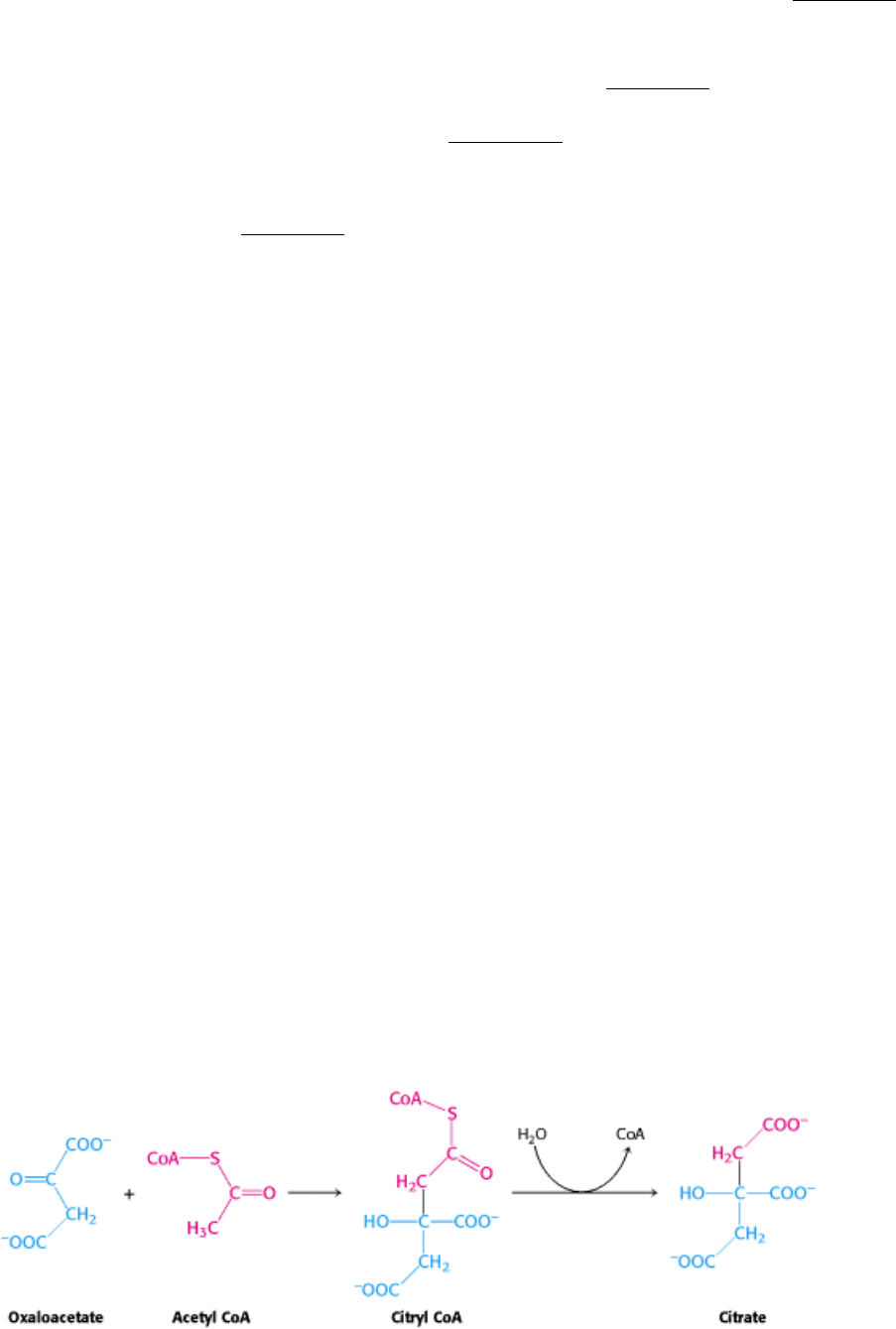
Although the structure of an intact member of the pyruvate dehydrogenase complex family has not yet been determined
in atomic detail, the structures of all of the component enzymes are now known, albeit from different complexes and
species. Thus, it is now possible to construct an atomic model of the complex to understand its activity (Figure 17.7).
The core of the complex is formed by E
2
. Acetyltransferase consists of eight catalytic trimers assembled to form a
hollow cube. Each of the three subunits forming a trimer has three major domains (Figure 17.8). At the amino terminus
is a small domain that contains a bound lipoamide cofactor attached to a lysine residue. This domain is homologous to
biotin-binding domains such as that of pyruvate carboxylase (see Figure 16.26). The lipoamide domain is followed by a
small domain that interacts with E
3
within the complex. A larger transacetylase domain completes an E
2
subunit. E
1
is an
α
2
β
2
tetramer, and E
3
is a α β dimer. Twenty-four copies of E
1
and 12 copies of E
3
surround the E
2
core. How do the
three distinct active sites work in concert (Figure 17.9)?
1. Pyruvate is decarboxylated at the active site of E
1
, forming the substituted TPP intermediate, and CO
2
leaves as the
first product. This active site lies within the E
1
complex, connected to the enzyme surface by a 20-Å-long hydrophobic
channel.
2. E
2
inserts the lipoyl-lysine arm of the lipoamide domain into the channel in E
1
.
3. E
1
catalyzes the transfer of the acetyl group to the lipoamide. The acetylated lipoyl-lysine arm then leaves E
1
and
enters the E
2
cube through 30 Å windows on the sides of the cube to visit the active site of E
2
, located deep in the cube
at the subunit interface.
4. The acetyl moiety is then transferred to CoA, and the second product, acetyl CoA, leaves the cube. The reduced lipoyl-
lysine arm then swings to the active site of the E
3
flavoprotein.
5. At the E
3
active site, the lipoamide acid is oxidized by coenzyme FAD.
6. The final product, NADH, is produced with the reoxidation of FADH
2
, and the reactivated lipoamide is ready to begin
another reaction cycle.
The structural integration of three kinds of enzymes makes the coordinated catalysis of a complex reaction possible. The
proximity of one enzyme to another increases the overall reaction rate and minimizes side reactions. All the
intermediates in the oxidative decarboxylation of pyruvate are tightly bound to the complex and are readily transferred
because of the ability of the lipoyl-lysine arm of E
2
to call on each active site in turn.
17.1.3. Citrate Synthase Forms Citrate from Oxaloacetate and Acetyl Coenzyme A
The citric acid cycle begins with the condensation of a four-carbon unit, oxaloacetate, and a two-carbon unit, the acetyl
group of acetyl CoA. Oxaloacetate reacts with acetyl CoA and H
2
O to yield citrate and CoA.

This reaction, which is an aldol condensation followed by a hydrolysis, is catalyzed by citrate synthase. Oxaloacetate
first condenses with acetyl CoA to form citryl CoA, which is then hydrolyzed to citrate and CoA. The hydrolysis of citryl
CoA, a high-energy thioester intermediate, drives the overall reaction far in the direction of the synthesis of citrate. In
essence, the hydrolysis of the thioester powers the synthesis of a new molecule from two precursors. Because this
reaction initiates the cycle, it is very important that side reactions be minimized. Let us briefly consider the how citrate
synthase prevents wasteful processes such as the hydrolysis of acetyl CoA.
Synthase-
An enzyme catalyzing a synthetic reaction in which two units are
joined without the direct participation of ATP (or another nucleoside
triphosphate).
Mammalian citrate synthase is a dimer of identical 49-kd subunits. Each active site is located in a cleft between the large
and small domains of a subunit, adjacent to the subunit interface. The results of x-ray crystallographic studies of citrate
synthase and its complexes with several substrates and inhibitors revealed that the enzyme undergoes large
conformational changes in the course of catalysis. Citrate synthase exhibits sequential, ordered kinetics: oxaloacetate
binds first, followed by acetyl CoA. The reason for the ordered binding is that oxaloacetate induces a major structural
rearrangement leading to the creation of a binding site for acetyl CoA. The open form of the enzyme observed in the
absence of ligands is converted into a closed form by the binding of oxaloacetate (Figure 17.10). In each subunit, the
small domain rotates 19 degrees relative to the large domain. Movements as large as 15 Å are produced by the rotation
of α helices elicited by quite small shifts of side chains around bound oxaloacetate. This conformational transition is
reminiscent of the cleft closure in hexokinase induced by the binding of glucose (Section 16.1.1).
Citrate synthase catalyzes the condensation reaction by bringing the substrates into close proximity, orienting them, and
polarizing certain bonds. Two histidine residues and an aspartate residue are important players (Figure 17.11). One of the
histidine residues (His 274) donates a proton to the carbonyl oxygen of acetyl CoA to promote the removal of a methyl
proton by Asp 375. Oxaloacetate is activated by the transfer of a proton from His 320 to its carbonyl carbon atom. The
concomitant attack of the enol of acetyl CoA on the carbonyl carbon of oxaloacetate results in the formation of a carbon-
carbon bond. The newly formed citryl CoA induces additional structural changes in the enzyme. The active site becomes
completely enclosed. His 274 participates again as a proton donor to hydrolyze the thioester. Coenzyme A leaves the
enzyme, followed by citrate, and the enzyme returns to the initial open conformation.
We can now understand how the wasteful hydrolysis of acetyl CoA is prevented. Citrate synthase is well suited to
hydrolyze citryl CoA but not acetyl CoA. How is this discrimination accomplished? First, acetyl CoA does not bind to
the enzyme until oxaloacetate is bound and ready for condensation. Second, the catalytic residues crucial for hydrolysis
of the thioester linkage are not appropriately positioned until citryl CoA is formed. As with hexokinase (Section 16.1.1)
and triose phosphate isomerase (Section 16.1.4), induced fit prevents an undesirable side reaction.
17.1.4. Citrate Is Isomerized into Isocitrate
The tertiary hydroxyl group is not properly located in the citrate molecule for the oxidative decarboxylations that follow.
Thus, citrate is isomerized into isocitrate to enable the six-carbon unit to undergo oxidative decarboxylation. The
isomerization of citrate is accomplished by a dehydration step followed by a hydration step. The result is an interchange
of a hydrogen atom and a hydroxyl group. The enzyme catalyzing both steps is called aconitase because cis-aconitate is
an intermediate.
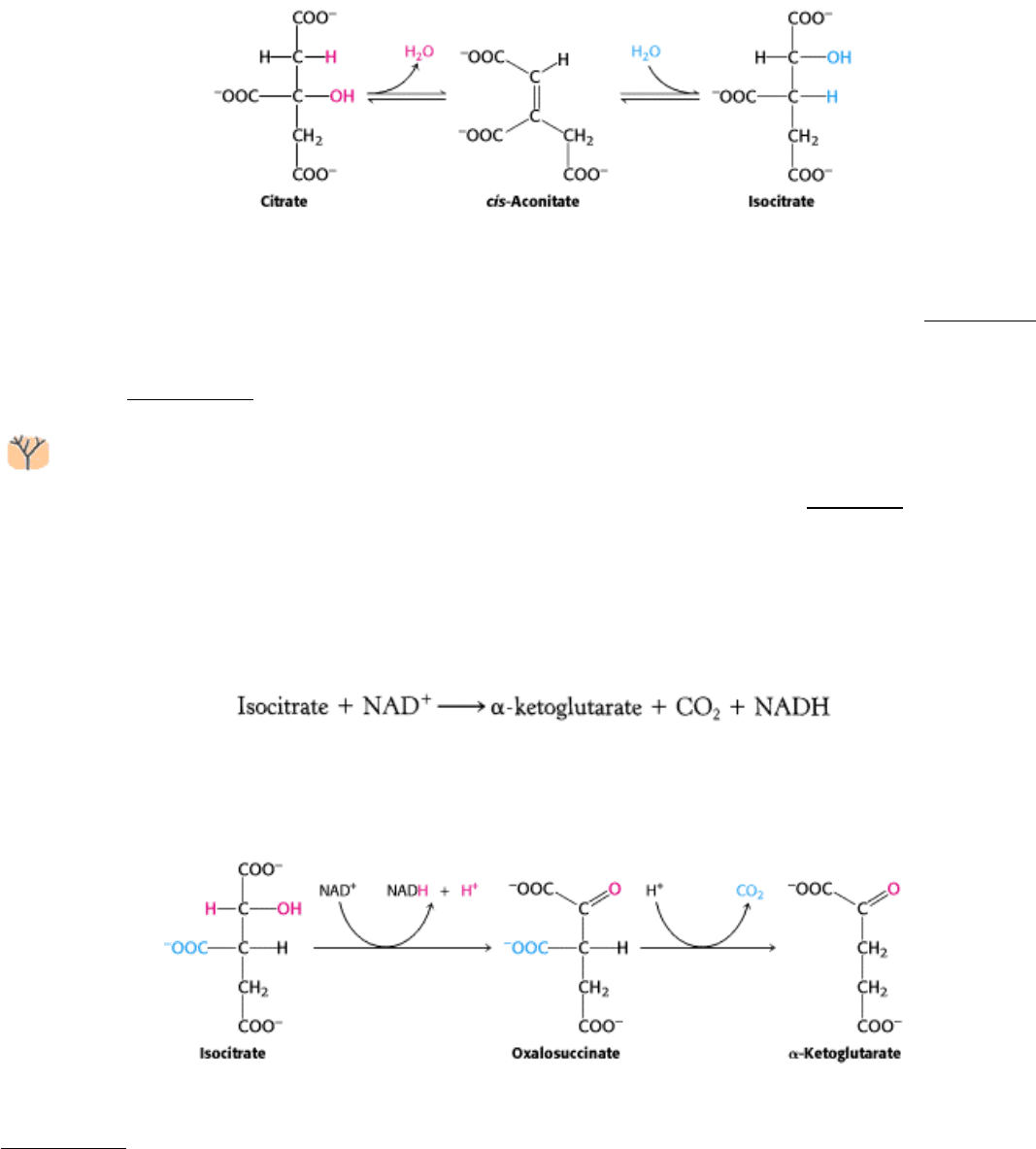
Aconitase is an iron-sulfur protein, or nonheme iron protein. It contains four iron atoms that are not incorporated as part
of a heme group. The four iron atoms are complexed to four inorganic sulfides and three cysteine sulfur atoms, leaving
one iron atom available to bind citrate and then isocitrate through their carboxylate and hydroxyl groups (Figure 17.12).
This iron center, in conjunction with other groups on the enzyme, facilitates the dehydration and rehydration reactions.
We will consider the role of these iron-sulfur clusters in the electron-transfer reactions of oxidative phosphorylation
subsequently (Section 18.3.1).
The iron-sulfur cluster in aconitase is somewhat unstable, so one or more iron atoms dissociate under conditions of
low iron availability in the cell. Remarkably, this sensitivity to iron level was exploited in the evolution of a
mechanism for regulating gene expression in response to iron levels, as will be discussed in Chapter 31.
17.1.5. Isocitrate Is Oxidized and Decarboxylated to α-Ketoglutarate
We come now to the first of four oxidation-reduction reactions in the citric acid cycle. The oxidative decarboxylation of
isocitrate is catalyzed by isocitrate dehydrogenase.
The intermediate in this reaction is oxalosuccinate, an unstable β-ketoacid. While bound to the enzyme, it loses CO
2
to
form α-ketoglutarate.
The rate of formation of α-ketoglutarate is important in determining the overall rate of the cycle, as will be discussed in
Section 17.2.2. This oxidation generates the first high-transfer-potential electron carrier NADH in the cycle.
17.1.6. Succinyl Coenzyme A Is Formed by the Oxidative Decarboxylation of α-
Ketoglutarate
The conversion of isocitrate into α-ketoglutarate is followed by a second oxidative decarboxylation reaction, the
formation of succinyl CoA from α-ketoglutarate.
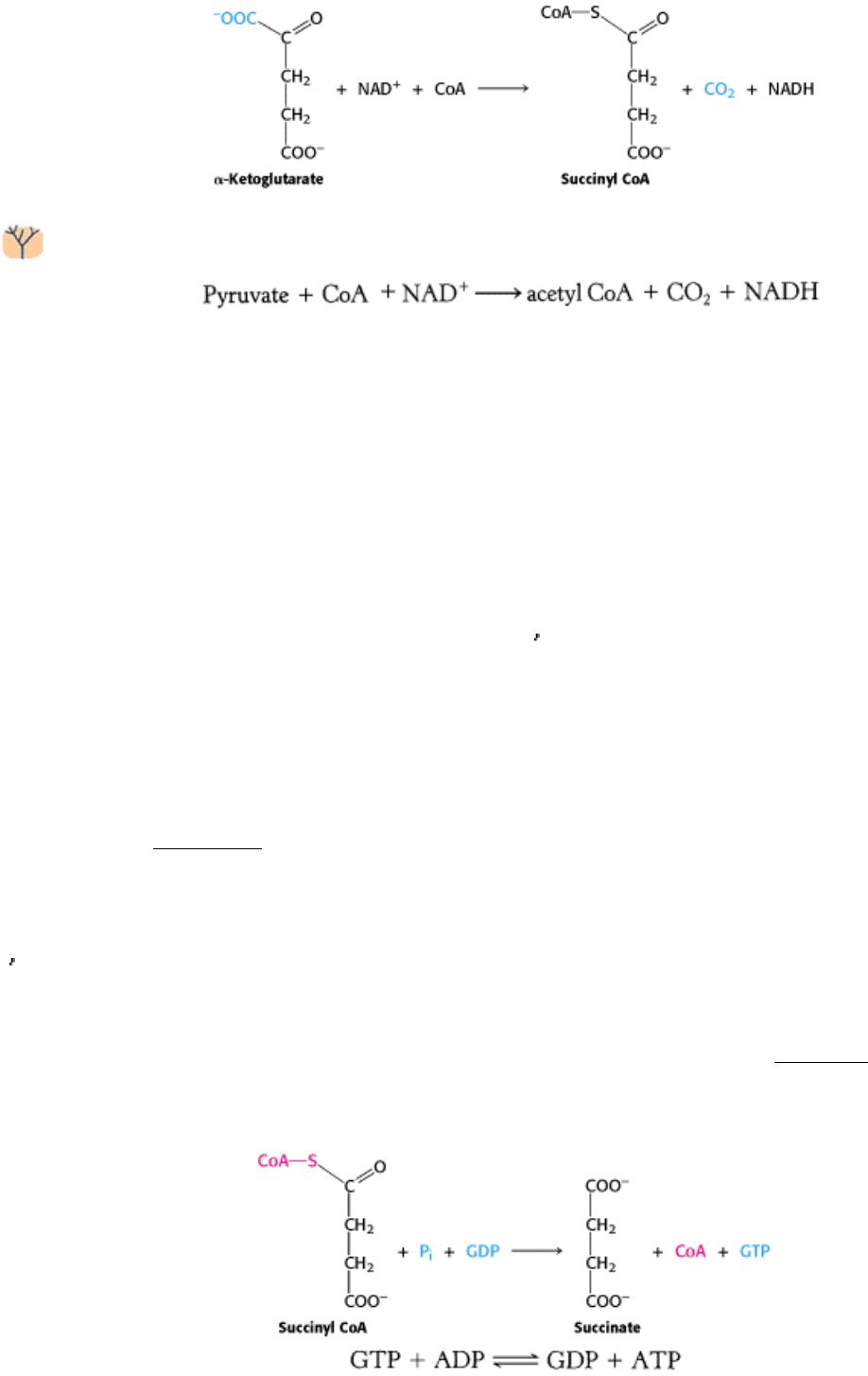
The oxidative decarboxylation of α-ketoglutarate closely resembles that of pyruvate, also an α-ketoacid.
Both reactions include the decarboxylation of an α-ketoacid and the subsequent formation of a high-transfer-potential
thioester linkage with CoA. The complex that catalyzes the oxidative decarboxylation of α-ketoglutarate is homologous
to the pyruvate dehydrogenase complex, and the reaction mechanism is entirely analogous. The α-ketoglutarate
dehydrogenase component (E
2
) and transsuccinylase (E
1
) are different from but homologous to the corresponding
enzymes in the pyruvate dehydrogenase complex, whereas the dihydrolipoyl dehydrogenase components (E
3
) of the two
complexes are identical.
17.1.7. A High Phosphoryl-Transfer Potential Compound Is Generated from Succinyl
Coenzyme A
Succinyl CoA is an energy-rich thioester compound. The ∆ G°
for the hydrolysis of succinyl CoA is about -8 kcal mol
-1
(-33.5 kJ mol
-1
), which is comparable to that of ATP (-7.3 kcal mol
-1
, or -30.5 kJ mol
-1
). In the ci-trate synthase
reaction, the cleavage of the thioester bond powers the synthesis of the six-carbon citrate from the four-carbon
oxaloacetate and the two-carbon fragment. The cleavage of the thioester bond of succinyl CoA is coupled to the
phosphorylation of a purine nucleoside diphosphate, usually GDP. This reaction is catalyzed by succinyl CoA synthetase
(succinate thiokinase). This enzyme is an α
2
β
2
heterodimer; the functional unit is one α β pair. The mechanism is a
clear example of energy transformations: energy inherent in the thioester molecule is transformed into phosphoryl-group
transfer potential (Figure 17.13). The first step is the displacement of coenzyme A by orthophosphate, which generates
another energy-rich compound, succinyl phosphate. A histidine residue of the α subunit removes the phosphoryl group
with the concomitant generation of succinate and phosphohistidine. The phosphohistidine residue then swings over to a
bound nucleoside diphosphate and the phosphoryl group is transferred to form the nucleoside triphosphate. The
participation of high-energy compounds in all the steps is attested to by the fact that the reaction is readily reversible: ∆ G
°
= -0.8 kcal mol
-1
(-3.4 kJ mol
-1
). This is the only step in the citric acid cycle that directly yields a compound with high
phosphoryl transfer potential through a substrate-level phosphorylation. Some mammalian succinyl CoA synthetases are
specific for GDP and others for ADP. The E. coli enzyme uses either GDP or ADP as the phosphoryl-group acceptor.
We have already seen that GTP is an important component of signal-transduction systems (Chapter 15). Alternatively, its
γ-phosphoryl group can be readily transferred to ADP to form ATP, in a reaction catalyzed by nucleoside
diphosphokinase.
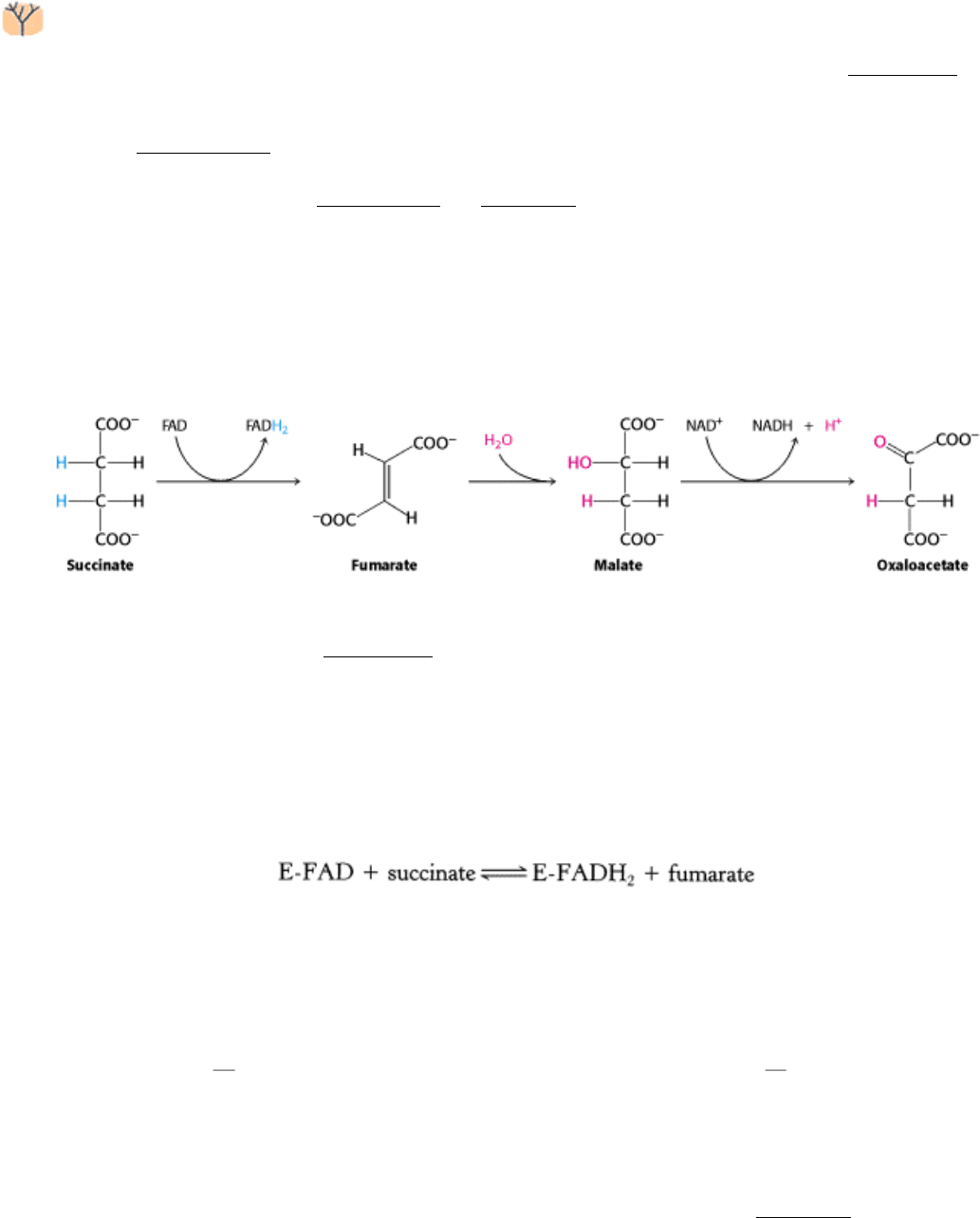
The mechanism of succinyl CoA synthetase reveals that a phosphoryl group is transferred first to succinyl CoA
bound in the α subunit and then to a nucleoside diphosphate bound in the β subunit. Examination of the three-
dimensional structure of succinyl CoA synthetase shows that each subunit comprises two domains (Figure 17.14). The
carboxyl-terminal domains of the two subunits are similar to one another, whereas the amino-terminal domains have
different structures, each characteristic of its role in the mechanism. The amino-terminal domain of the α subunit forms a
Rossmann fold (Section 16.1.10), which binds the ADP component of succinyl CoA, whereas the amino-terminal
domain of the β subunit is an ATP-grasp domain, a nucleotide-activating domain found in many enzymes, especially
those catalyzing purine biosynthesis (Section 16.3.2 and Chapter 25). Succinyl CoA synthetase has evolved by adopting
these domains and harnessing them to allow the capture of the energy associated with succinyl CoA cleavage to drive the
generation of a nucleoside triphosphate.
17.1.8. Oxaloacetate Is Regenerated by the Oxidation of Succinate
Reactions of four-carbon compounds constitute the final stage of the citric acid cycle: the regeneration of oxaloacetate.
The reactions constitute a metabolic motif that we will see again in fatty acid synthesis and degradation as well as in the
degradation of some amino acids (see Figure 14.17). A methylene group (CH
2
) is converted into a carbonyl group (C =
O) in three steps: an oxidation, a hydration, and a second oxidation reaction. Not only is oxaloacetate thereby
regenerated for another round of the cycle, but also more energy is extracted in the form of FADH
2
and NADH.
Succinate is oxidized to fumarate by succinate dehydrogenase. The hydrogen acceptor is FAD rather than NAD
+
, which
is used in the other three oxidation reactions in the cycle. In succinate dehydrogenase, the isoalloxazine ring of FAD is
covalently attached to a histidine side chain of the enzyme (denoted E-FAD).
FAD is the hydrogen acceptor in this reaction because the free-energy change is insufficient to reduce NAD
+
. FAD is
nearly always the electron acceptor in oxidations that remove two hydrogen atoms from a substrate.
Succinate dehydrogenase, like aconitase, is an iron-sulfur protein. Indeed, succinate dehydrogenase contains three
different kinds of iron-sulfur clusters, 2Fe-2S (two iron atoms bonded to two inorganic sulfides), 3Fe-4S, and 4Fe-4S.
Succinate dehydrogenase
which consists of two subunits, one 70 kd and the other 27 kd differs from other enzymes
in the citric acid cycle in being embedded in the inner mitochondrial membrane. In fact, succinate dehydrogenase is
directly associated with the electron-transport chain, the link between the citric acid cycle and ATP formation. FADH
2
produced by the oxidation of succinate does not dissociate from the enzyme, in contrast with NADH produced in other
oxidation-reduction reactions. Rather, two electrons are transferred from FADH
2
directly to iron-sulfur clusters of the
enzyme. The ultimate acceptor of these electrons is molecular oxygen, as we shall see in Chapter 18.
The next step is the hydration of fumarate to form
l-malate. Fumarase catalyzes a stereospecific trans addition of a
hydrogen atom and a hydroxyl group. The hydroxyl group adds to only one side of the double bond of fumarate; hence,
only the l isomer of malate is formed.
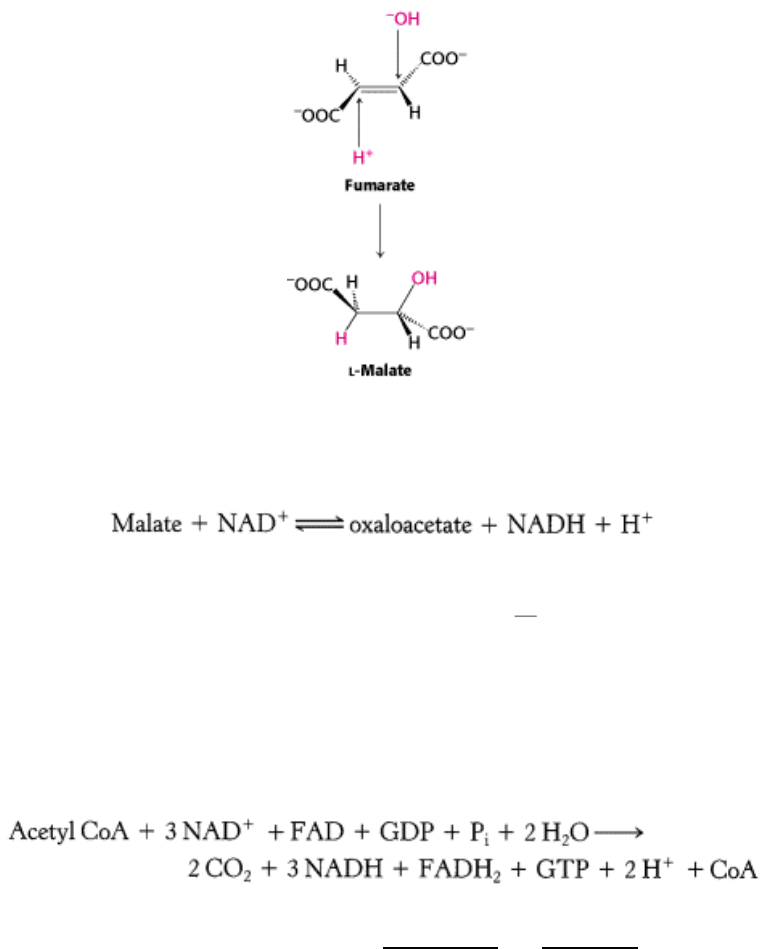
Finally, malate is oxidized to form oxaloacetate. This reaction is catalyzed by malate dehydrogenase, and NAD
+
is again
the hydrogen acceptor.
Note that the standard free energy for this reaction, unlike that for the other steps in the citric acid cycle, is significantly
positive. The oxidation of malate is driven by the utilization of the products
oxaloacetate by citrate synthase and
NADH by the electron-transport chain.
17.1.9. Stoichiometry of the Citric Acid Cycle
The net reaction of the citric acid cycle is:
Let us recapitulate the reactions that give this stoichiometry (Figure 17.15 and Table 17.2):
1. Two carbon atoms enter the cycle in the condensation of an acetyl unit (from acetyl CoA) with oxaloacetate. Two
carbon atoms leave the cycle in the form of CO
2
in the successive decarboxylations catalyzed by isocitrate
dehydrogenase and α-ketoglutarate dehydrogenase. Interestingly, the results of isotope-labeling studies revealed that the
two carbon atoms that enter each cycle are not the ones that leave.
2. Four pairs of hydrogen atoms leave the cycle in four oxidation reactions. Two molecules of NAD
+
are reduced in the
oxidative decarboxylations of isocitrate and α -ketoglutarate, one molecule of FAD is reduced in the oxidation of
succinate, and one molecule of NAD
+
is reduced in the oxidation of malate.
3. One compound with high phosphoryl transfer potential, usually GTP, is generated from the cleavage of the thioester
linkage in succinyl CoA.
4. Two molecules of water are consumed: one in the synthesis of citrate by the hydrolysis of citryl CoA and the other in
the hydration of fumarate.
Recall also that NADH is generated in the formation of acetyl CoA from pyruvate by the pyruvate dehydrogenase
reaction.
